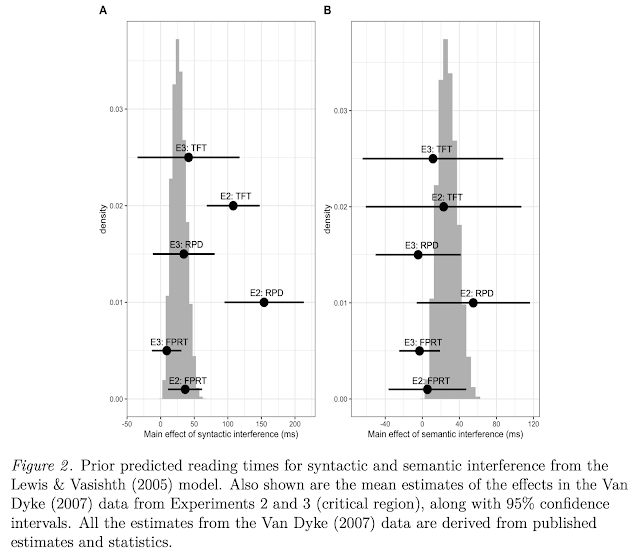This paper is part of a larger project that has been running for 4-5 years, on the predictions of cue-based retrieval theories. This paper revisits
Van Dyke 2007's design, using eye-tracking (the data are from comparable designs in English and German). The reading time patterns are consistent with syntactic interference at the moment of retrieval in both English. Semantic interference shows interesting differences between English and German---in English, semantic interference seems to happen simultaneously with syntactic interference, but in German, semantic interference is delayed (it appears in the post-critical region). The morphosyntactic properties of German could be driving the lag in semantic interference. We also discuss the data in the context of the quantitative predictions from
the Lewis & Vasishth cue-based retrieval model.
One striking fact about psycholinguistics in general and interference effects in particular is that most of the data tend to come from English. Very few people work on non-English languages. I bet there are a lot of surprises in store for us once we step out of the narrow confines of English. I bet that most theories of sentence processing are overfitted to English and will not scale. And if you submit a paper to a journal using data from a non-English language, there will always be a reviewer or editor who asks you to explain why you chose language X!=English, and not English. Nobody ever questions you if you study English. A bizarre world.
Title: Syntactic and semantic interference in sentence comprehension: Support from English and German eye-tracking data
Abstract:
A long-standing debate in the sentence processing literature concerns the time course of
syntactic and semantic information in online sentence comprehension. The default assumption
in cue-based models of parsing is that syntactic and semantic retrieval cues simultaneously
guide dependency resolution. When retrieval cues match multiple items in memory, this
leads to similarity-based interference. Both semantic and syntactic interference have been
shown to occur in English. However, the relative timing of syntactic vs. semantic interference
remains unclear. In this first-ever cross-linguistic investigation of the time course of syntactic
vs. semantic interference, the data from two eye-tracking reading experiments (English and
German) suggest that the two types of interference can in principle arise simultaneously
during retrieval. However, the data also indicate that semantic cues may be evaluated
with a small timing lag in German compared to English. This suggests that there may be
cross-linguistic variation in how syntactic and semantic cues are used to resolve linguistic
dependencies in real-time.
Download pdf from here: https://psyarxiv.com/ua9yv


No comments:
Post a Comment